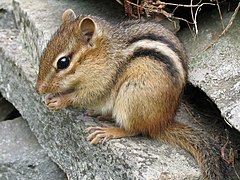Pręgowiec[3] (Tamias) – rodzaj ssaków z podrodziny afrowiórek (Xerinae) w obrębie rodziny wiewiórkowatych (Sciuridae).
Szybkie fakty Domena, Królestwo ...
Zamknij
Rodzaj obejmuje jeden żyjący współcześnie gatunek występujący w Ameryce Północnej[4][5][6].
Długość ciała (bez ogona) 145,9–150 mm, długość ogona 87,7–93,2 mm; masa ciała 93,9–101 g[5][7].
Rodzaj zdefiniował w 1811 roku niemiecki zoolog Johann Karl Wilhelm Illiger w książce swojego autorstwa o tytule Prodromus systematis mammalium et avium[1]. Na gatunek typowy Illiger wyznaczył (oznaczenie monotypowe) pręgowca amerykańskiego (T. striatus).
Etymologia
Tamias (Tamia): gr. ταμιας ‘zarządca, szafarz, gospodarz’ (w aluzji do zwyczaju gromadzenia jedzenia przez pręgowce)[8].
Podział systematyczny
Dawniej rodzaj obejmował gatunki z rodzajów Neotamias oraz Eutamias[6], jednak wysoka rozbieżność genetyczna między każdym z trzech kladów potwierdza ich uznanie za odrębne rodzaje[9]. Do rodzaju Tamias zaliczany jest jeden występujący współcześnie gatunek[10][7][4][3]:
Opisano również gatunki wymarłe:
- Tamias allobrogensis Mein & Ginsburg, 2002[11] (Europa; miocen)
- Tamias aristus Ray, 1965[12] (Ameryka Północna; plejstocen)
- Tamias ertemtensis (Qiu Zhuding, 1991)[13] (Azja; miocen)
- Tamias eviensis De Bruijn, Van der Meulen & Katsikatsos, 1980[14] (Europa; miocen)
- Tamias gilaharee Patnaik, N.P. Singh, Sharma, N.A. Singh, Choudhary, Y.P. Singh, Kumar, Wazir & Sahni, 2022[15] (Azja; miocen)
- Tamias lishanensis (Qiu Zhuding, Zheng Shaohua & Zhang Zhaoqun, 2008)[16] (Azja; miocen)
- Tamias minutus (Lartet, 1851)[17] (Europa; miocen)
- Tamias orlovi (Sulimski, 1964)[18] (Europa; pliocen)
- Tamias urialis (Munthe, 1980)[19] (Azja; miocen)
- Tamias wimani Yang Zhongjian, 1927[20] (Azja; plejstocen)
Niepoprawna późniejsza pisownia Tamias Illiger, 1811.
W. Cichocki, A. Ważna, J. Cichocki, E. Rajska-Jurgiel, A. Jasiński & W. Bogdanowicz: Polskie nazewnictwo ssaków świata. Warszawa: Muzeum i Instytut Zoologii PAN, 2015, s. 211. ISBN 978-83-88147-15-9. (pol. • ang.). J. Koprowski, E. Goldstein, K. Bennett & C. Pereira: Family Sciuridae (Tree, Flying and Ground Squirrels, Chipmunks, Prairie Dogs and Marmots). W: D.E. Wilson, T.E. Lacher, Jr & R.A. Mittermeier (redaktorzy): Handbook of the Mammals of the World. Cz. 6: Lagomorphs and Rodents I. Barcelona: Lynx Edicions, 2016, s. 795. ISBN 978-84-941892-3-4. (ang.). D.E. Wilson & D.M. Reeder (redaktorzy): Genus Tamias. [w:] Mammal Species of the World. A Taxonomic and Geographic Reference (Wyd. 3) [on-line]. Johns Hopkins University Press, 2005. [dostęp 2022-12-21]. Class Mammalia. W: Lynx Nature Books: All the Mammals of the World. Barcelona: Lynx Edicions, 2023, s. 399. ISBN 978-84-16728-66-4. (ang.). B.D. Patterson & R.W. Norris. Towards a uniform nomenclature for ground squirrels: the status of the Holarctic chipmunks. „Mammalia”. 80 (3), s. 241–251, 2015. DOI: 10.1515/mammalia-2015-0004. (ang.). N. Upham, C. Burgin, J. Widness, M. Becker, C. Parker, S. Liphardt, I. Rochon & D. Huckaby: Treeview of Mammalian Taxonomy Hierarchy. [w:] ASM Mammal Diversity Database (Version 1.11) [on-line]. American Society of Mammalogists. [dostęp 2023-10-21]. (ang.). C.E. Ray. A new chipmunk, Tamias aristus, from the Pleistocene of Georgia. „Journal of Paleontology”. 39 (5), s. 1018, 1965. DOI: 10.2307/3555320. (ang.). Z. Qiu. The Neogene mammalian faunas of Ertemte and Harr Obo in Inner Mongolia (Nei Mongol), China. 8. Sciuridae (Rodentia). „Senckenbergiana lethaea”. 71 (3/4), s. 223–255, 1991.
H. de Bruijn, A.J. van der Meulen & G. Katsikatsos. The mammals from the Lower Miocene of Aliveri (Island of Evia, Greece). Part 1. The Sciuridae. „Proceedings of the Koninklijke Akademie van Wetenschappen”. Series B Physical Sciences. 83 (3), s. 241–261, 1980. (ang.). R. Patnaik, N.P. Singh, K.M. Sharma, N.A. Singh, D. Choudhary, Y.P. Singh, R. Kumar, W.A. Wazir & A. Sahni. New rodents shed light on the age and ecology of late Miocene ape locality of Tapar (Gujarat, India). „Journal of Systematic Palaeontology”. 20 (1), s. 2084701 (25), 2022. DOI: 10.1080/14772019.2022.2084701. (ang.). Z.-j. Yang (C.C. Young). Fossile Nagetiere aus Nord-China. „Palaeontologia Sinica”. Series C. 5 (3), s. 1–82, 1927. (niem.).
Identyfikatory zewnętrzne:
